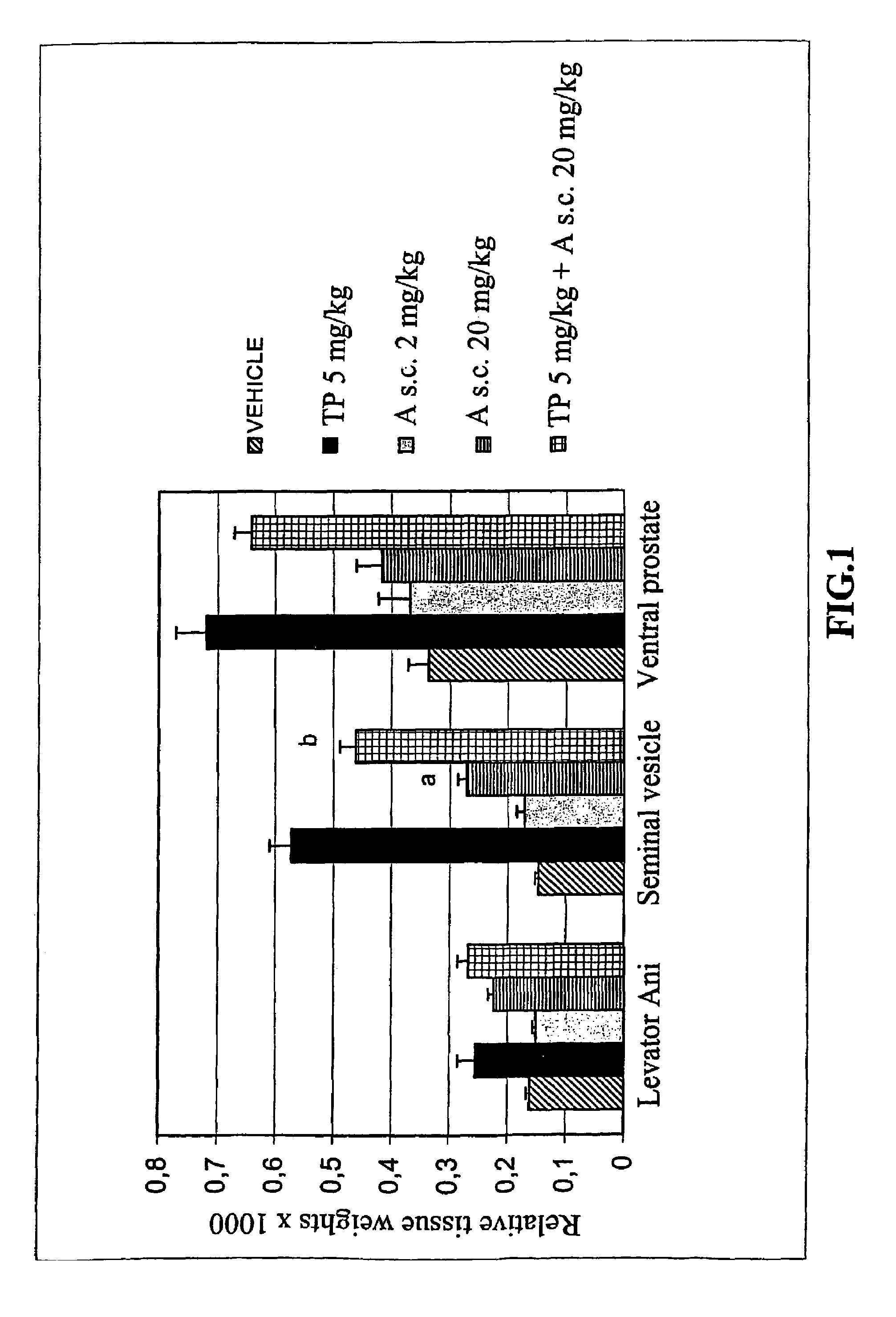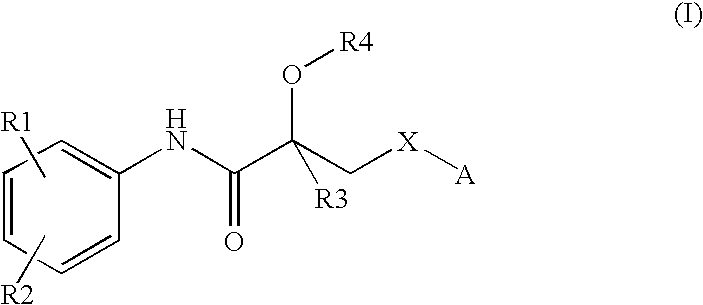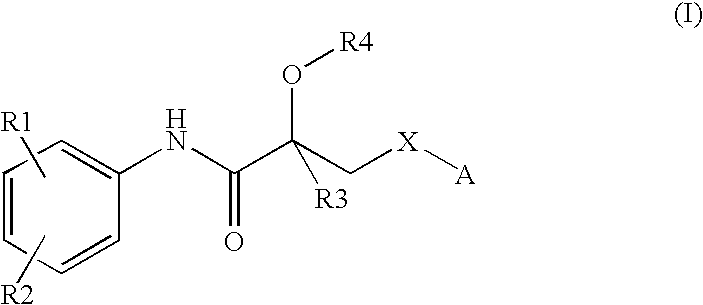Propionamide derivatives useful as androgen receptor modulators
a technology of androgen receptor and propionamide, which is applied in the direction of amide active ingredients, drug compositions, medical preparations, etc., can solve the problems of low systemic bioavailability after oral administration, severe limitations of current steroidal androgens, such as synthesized testosterone and its derivatives, and achieves beneficial androgenic effects, high affinity and activity of androgen receptors, and is suitable for use
- Summary
- Abstract
- Description
- Claims
- Application Information
AI Technical Summary
Benefits of technology
Problems solved by technology
Method used
Image
Examples
experiment 1
AR Binding Assay
[0092]Ventral prostates were obtained form rats castrated 24 h prior to sacrifice. Fresh prostate was minced and washed with Buffer A (Schilling and Liao, Prostate, 5:581-588, 1984). The minces were then homogenized in 3× volume of Buffer A containing protease inhibitors (Complete, Mini, EDTA-free Roche). The homogenate was centrifuged at 30000 g for 30 min. The resultant supernatants were treated with 1×volume of dextran-coated charcoal solution (12.5 g activated charcoal, 12.5 g dextran per liter of buffer A) to remove endogenous steroids. The samples were incubated for 5 min and centrifuged at 16000 g for 10 min. Aliquots of the charcoal-treated cytosol were taken for androgen receptor assays. All procedures were carried out at 0-4° C.
[0093]Cytosol androgen receptor concentration was determined as described (Isomaa et al., Endocrinology, 111: 833-843, 1982) with minor modifications. Cytosol preparations were prepared as described above, and bound and free steroids...
experiment 2
Ar Agonism and Antagonism in Immature Male Rats
[0096]The title compound of Example 3, abbreviated here as compound A, was further studied in in vivo experiment. The agonism and antagonism of the compound with subcutaneous dosing was tested in immature male Spraque Dawley rat 3-day assay by analyzing the relative weights of ventral prostate, seminal vesicle, and levator ani-muscle. Testosterone propionate was used as a reference compound.
[0097]Testosterone propionate (abbreviated here TP) and compound A were first dissolved into DMSO and then into the vehicle sesame oil. Sprague-Dawley untreated male rats (18-19 days old) weighing about 50 g were used in the experiment. Rats were weighed and randomly distributed into five groups, with 5 animals per group (Table 1). Compound A (doses 2 and 20 mg / kg) and testosterone propionate (dose 5 mg / kg) were given subcutaneously (s.c.) into the neck / back of the animals at a constant volume of 100 microl dosing solution / animal / day. The animals wer...
example 1
Method A
3-(4-Acetylaminophenoxy)-2-hydroxy-2-methyl-N-(3-methyl-4-nitrophenyl)propionamide
a) 2-Methyl-N-(3-methyl-4-nitrophenyl)acrylamide
[0100]3-Methyl-4-nitroaniline (2.0 g, 13 mmol) in N,N-dimethylacetamide (DMAC) (6 ml) was added dropwise to a cooled solution of methacryloyl chloride (2.0 ml, 20.7 mmol) in a nitrogen atmosphere while the temperature of the reaction mixture was maintained between 0-5° C. The solution was allowed to warm to room temperature and the mixture was stirred over night. The mixture was poured into water (70 ml) and extracted with ethyl acetate (4×40 ml). The organic phase was washed with saturated Na2CO3 (3×20 ml) and water (1×50 ml), dried over Na2SO4 and evaporated. The yield of the crude product was 4.17 g (contains DMA, theoretical yield 2.9 g), and it was used without further purifications. 1H NMR (DMSO-d6): 1.97 (3H, s), 2.55 (3H, s), 5.62 (1H, m), 5.96 (1H, m), 7.80 (2H, m), 8.05 (1H, m), 10.22 (1H, s).
b) 2-Methyloxirane-2-carboxylic acid (3-methy...
PUM
| Property | Measurement | Unit |
|---|---|---|
| volume | aaaaa | aaaaa |
| temperature | aaaaa | aaaaa |
| temperature | aaaaa | aaaaa |
Abstract
Description
Claims
Application Information
 Login to View More
Login to View More - R&D
- Intellectual Property
- Life Sciences
- Materials
- Tech Scout
- Unparalleled Data Quality
- Higher Quality Content
- 60% Fewer Hallucinations
Browse by: Latest US Patents, China's latest patents, Technical Efficacy Thesaurus, Application Domain, Technology Topic, Popular Technical Reports.
© 2025 PatSnap. All rights reserved.Legal|Privacy policy|Modern Slavery Act Transparency Statement|Sitemap|About US| Contact US: help@patsnap.com



